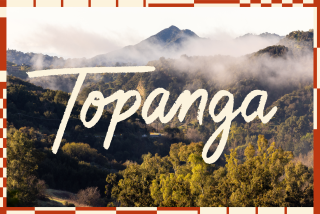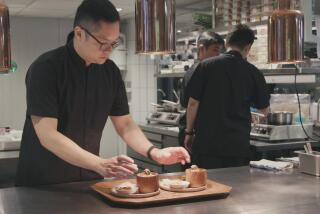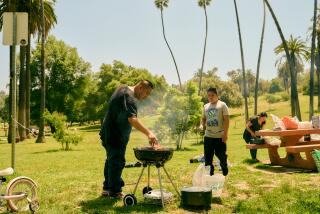Destination: Malaysia : Highlands Fling : Misty hillsides and vestiges of Scotland in Southeast Asia
TANAH RATA, Malaysia — It was a steamy Singapore morning when my Danish-born wife, Helle, and I boarded the 7:30 a.m. Ekspres Rakyat for a train ride to Kuala Lumpur, jumping off place for the Cameron Highlands, Malaysia’s largest British hill station. We were beckoned by the promise of hills and mountains in this former mountain retreat of British colonialists in Malaysia, a cooler clime and for me, an Englishman, a reconnection with my home--welcome after weeks on the road through some of Asia’s hottest and most congested cities.
The six-hour journey in a first-class coach came complete with Tom and Jerry videos and hostess service. Complimentary cake and soy milk were handed out to start the day and Tom and Jerry hit the screen shortly after we crossed the causeway onto the Malay Peninsula.
The Eastern & Orient Express now shares the same track but glides opulently on past Kuala Lumpur to Penang, then into Thailand, terminating in Bangkok. For a fraction of the cost we shared the same views although, regrettably, not the same champagne.
Through a green passageway of vegetation lining both sides of the track, through what is often called the world’s oldest rain forest, we snaked up Malaysia’s spine.
“Will you be staying, then, in Kuala Lumpur?” gently quizzed one of our fellow passengers. “Overnight, but our plan is to visit the Cameron Highlands,” I replied. “In search of a little piece of England?” our seatmate inquired.
Well, yes.
It had been many years since I clipped photographs of the Cameron Highlands from a travel magazine and tucked them away for future reference. One was of Ye Olde Smokehouse, a Tudor-style hotel, where dahlias dotted the grounds and ivy clung to the walls. I recalled another showing a perfectly manicured golf course topped by clouds that scudded over the tops of the encircling hills. It looked just like the Scottish Highlands.
“A fine plateau with gentle slopes, shut in by lofty mountains” the description with the photos said. The words were William Cameron’s, a government surveyor for which the area was named. They intrigued me. Would there be strawberries and cream on lazy afternoons, or single malts to lift the chill from wintry nights? Would it feel like home to me, this foreign spot with
the Scottish sounding name, tucked high in the hills of central Malaysia?
Scottish poet Robert Burns wrote, “My heart is in the Highlands, wherever I go.” Many British expatriates, building new lives overseas, yearned for the Highlands they had left behind--and thus were born hill stations in many locations around Asia.
After lunch, we stepped down from the train car into Kuala Lumpur’s beautiful onion-domed station. Beneath its minarets, a glass and iron frame reinforced the region’s British links, reflecting the style of railway stations around the United Kingdom.
But Kuala Lumpur, with its six-lane highways and busy shopping plazas, could wait. Helle and I would find time on our return from the hills to check out Malaysia’s modern capital of 1 million, with its gleaming new office buildings, vibrant Chinatown and tempting, spice-scented Indian quarter.
After a night in town, we clambered aboard the express bus to the town of Tanah Rata for a wild five-hour ride to the Highlands. The serpentine stretch of road between the village of Tapah and Tanah Rata, I had read in a guidebook, had more than 600 corners. Not that I counted, but our driver had a penchant for passing on almost every one, all the while chatting with a passenger three rows back.
*
It was 1885, while out on a mapping expedition, that British surveyor William Cameron “discovered” the Highlands. With temperatures averaging 70 degrees by day and 50 degrees at night, the British were drawn to this temperate zone and its familiar landscape, and began to fashion a home away from the heat and humidity enveloping the lowlands below. It wasn’t until the 1920s that the hill station was established, along with small farms growing European vegetables, citrus and, at the top, tea plantations. Local people were drafted to clear the land and Tamil laborers familiar with tea cultivation were brought over from southern India to work.
Flower growing also blossomed and soon the Highlands became an important source for the produce markets of Malaysia and Singapore. The Scottish link grew when a five-hole golf course was completed in 1935.
Today, the golf course has 18 holes and a day’s green fees are about $17. The tea plantations flourish and the mock Tudor hotel, Ye Olde Smokehouse, that had first caught my eye, has 13 suites.
Although the area encompassed by the Highlands is rather loosely defined by a series of tiny villages at an altitude of 4,900 to 6,000 feet, there are three major towns: Ringlet, Tanah Rata and Brinchang. We stayed in the largest, Tanah Rata, which is between the other two.
En route to Tanah Rata, our bus passed through Ringlet, a busy market town and distribution point for familiar vegetables grown in abundance on the surrounding fertile slopes: lettuce, tomatoes and a variety of other greens.
Brinchang lies just a few miles up the road. It, too, was packed with fruit and vegetables cultivated in the terraced market gardens cut into the adjoining hills.
But it was in Tanah Rata, with its typically English, small central park, and surrounding rolling green slopes that I felt as if I were in the British Isles. I even managed to find my strawberries and cream for sale in a local cafe.
*
Near Tanah Rata, butterflies blundered along with us on short walks through the greenery, up toward the misty peaks of the surrounding jungle. Hiking is a popular pastime in the fresh air of the Highlands--indeed, one of the few pastimes--and many routes are mapped. But it is easy to stray and getting lost could mean staying lost. So it is important to get a map from the Tanah Rata tourist office (on the main drag of jalan Pasar) and, if you wish to do any exploring, to hire a guide familiar with the area.
The warnings are not without merit. It was in the Cameron Highlands in 1967 that famed American silk trader, Jim Thompson, then living in Bangkok, disappeared while hiking, never to be seen again. The mystery of his disappearance was never solved.
One day we signed up (at a small travel agency on jalan Pasar) for a local minibus tour high into the hills past small farms linked to the roadside by winches and pulleys--installed to ferry produce by basket up from the steep terraced hillsides for collection and market each day. We passed roadside market stalls crammed with flowers, fruit and vegetables: rambutans, mangosteens, jackfruit, papayas and pungent durians. (We saw signs on the doors of hotels and bars ordering “No Durians”--a visual reminder of the fruit’s astonishingly offensive smell.) I also saw more familiar cabbages, lettuces, tomatoes, cauliflowers, strawberries, tangerines and grapefruit. Everything flourishes in this lush and fecund spot. Roses, dahlias and carnations evoked images of Scotland, especially when mists wrapped the hills and rain began to fall.
High in the hills we came upon the Boh Tea Estate, among other tea plantations. There was no charge for visiting and we watched picking and packing. Wrapped in plastic sheeting for protection against the damp, cool air, men and women workers wielding great plastic garden shears, tossed the tea clippings over their heads into baskets on their backs. We were told the pickers were from Bangladesh.
Our evenings in Tanah Rata were restricted to a bit of music in the town’s karaoke bar or a visit to one of several Chinese restaurants, or the Malay food stalls serving satays, tahu goreng (fried tofu) and many other spiced dishes flavored with peanuts, tamarind and anchovies. The cuisine of Malaysia reflects its rich ethnic mix: part Chinese, part Indian, part Indonesian and, of course, part Malay. In cities, familiar burger and fried chicken bars abound. But off in the villages, I grew fond of nasi lemak (rice cooked in coconut milk) served up for breakfast with anchovies, chili sauce, onions, prawn paste and a sliced hard-cooked egg. In the Highlands we sampled the local specialty, steamboat, a sort of Malaysian fondue in which thinly sliced meat, fish and vegetables are cooked in a simmering stock at your table. Our favorite spot for dining in Tanah Rata was the modestly named Excellent Restaurant.
By the sixth and last day, I was feeling at home in this strange blend of East and West, this amalgam of memories of England, Ireland, Scotland and Wales cobbled together by long-gone colonists.
Very early on the last morning, as the first fingers of light probed through gaps in the encircling hills, the sense of being close to home, somewhere high in the Scottish highlands came over me. From the mosque a haunting call to prayer dashed the early silence to herald the new day. In my confused half-awake state I was uncertain about where--East or West--I had rested my head. I had found what I came for: A sense of home that would refresh and prepare me for my return to the bustle and heat of the Asian cities down below, much like it had my forefathers before.
(BEGIN TEXT OF INFOBOX / INFOGRAPHIC)
GUIDEBOOK: Heading for the Cameron Hills
Getting there: Singapore Air and United fly direct, with no change of planes, from LAX to Singapore. Cathay Pacific, Northwest, JAL and Malaysian Airlines offer connecting service. Lowest advance-purchase, round-trip fares start at about $970.
From Singapore, take the train or fly to Kuala Lumpur. (Advance booking is essential for both.)
A nonstop bus to Tanah Rata departs daily from Pudu Raya bus station in Kuala Lumpur at 8.30 a.m. The journey takes about five hours and costs about $13 round trip.
Or take a taxi. Taxis in Malaysia are relatively cheap. The fare from Kuala Lumpur to Tanah Rata is about $77.
Or take a tour from Kuala Lumpur, available through many luxury hotels.
Where to stay: Accommodation prices can vary widely and are often negotiable. The mock Tudor style inn, Ye Olde Smokehouse, P.O. Box 77, Tanah Rata (midway between Tanah Rata and Brinchang); rates for a suite range from about $150 to $214; from the U.S. telephone 011-60-5-4911214.
The Strawberry Park resort, P.O. Box 81, Tanah Rata (also between Tanah Rata and Brinchang), near the golf course, is new and modern. Rates for a double room begin at about $94; tel. 011-60-5-4911166; fax: 054911949.
Inexpensive and modest guest house accommodations are also available in Tanah Rata.
For more information: Malaysia Tourism Promotion Board, 818 W. 7th St., Los Angeles 90017; (213) 689-9702; fax (213) 689-1530.
--S.H.
More to Read
Sign up for The Wild
We’ll help you find the best places to hike, bike and run, as well as the perfect silent spots for meditation and yoga.
You may occasionally receive promotional content from the Los Angeles Times.






